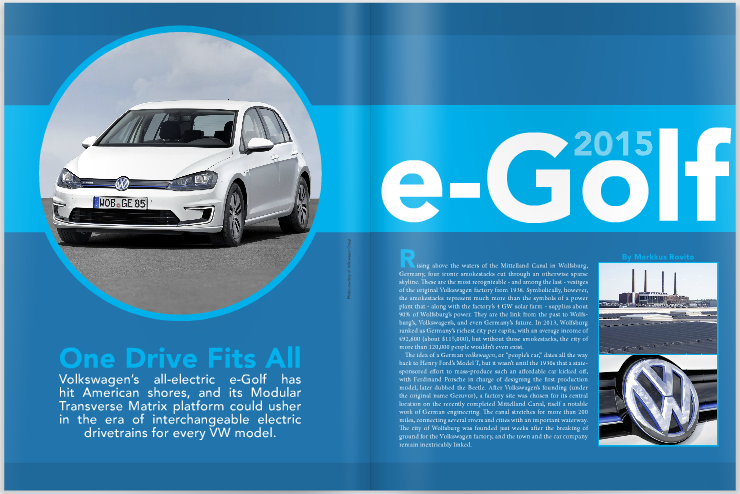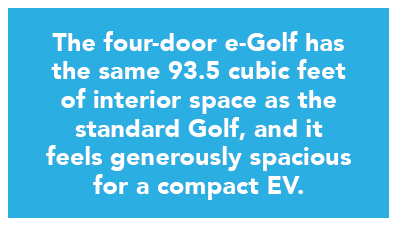Rising above the waters of the Mittelland Canal in Wolfsburg, Germany, four iconic smokestacks cut through an otherwise sparse skyline. These are the most recognizable – and among the last – vestiges of the original Volkswagen factory from 1938. Symbolically, however, the smokestacks represent much more than the symbols of a power plant that – along with the factory’s 4 GW solar farm – supplies about 90% of Wolfsburg’s power. They are the link from the past to Wolfsburg’s, Volkswagen’s, and even Germany’s future. In 2013, Wolfsburg ranked as Germany’s richest city per capita, with an average income of €92,600 (about $115,000), but without those smokestacks, the city of more than 120,000 people wouldn’t even exist.


The idea of a German volkswagen, or “people’s car,” dates all the way back to Henry Ford’s Model T, but it wasn’t until the 1930s that a state-sponsored effort to mass-produce such an affordable car kicked off, with Ferdinand Porsche in charge of designing the first production model, later dubbed the Beetle. After Volkswagen’s founding (under the original name Gezuvor), a factory site was chosen for its central location on the recently completed Mittelland Canal, itself a notable work of German engineering. The canal stretches for more than 200 miles, connecting several rivers and cities with an important waterway. The city of Wolfsburg was founded just weeks after the breaking of ground for the Volkswagen factory, and the town and the car company remain inextricably linked.
Today about 60,000 people, or around half of Wolfsburg’s population, are employed directly or indirectly by Volkswagen, and while its factory smokestacks still hark back to the grimy heyday of 20th-century industrialism, a thoroughly modern vision has sprung up around them. Across the canal from the factory, a five-star Ritz Carlton hotel gives way to the manicured lawns and architectural wonders of the Autostadt, Volkswagen’s automotive Disneyland of sorts. The 28-hectare museum and park complex hosts several buildings of classic car exhibits, interactive installations and other entertainment. The Autostadt provides a destination for the estimated 25-33% of German Volkswagen customers who physically pick up their new vehicles from VW’s headquarters in Wolfsburg – averaging 500-600 pick-ups a day. The Autostadt’s two glass Cartowers store about 400 cars each, and when it’s time to retrieve one for its new owner, like a giant automobile vending machine, a hydraulic system ascends up to 20 stories to quickly fetch it. The Guinness Book of World Records recognizes it as the “fastest automatic parking system in the world.”
Yet the heartbeat of Wolfsburg and Volkswagen still emanates from the factory behind those smokestacks. At 6.5 square kilometers, it is to this day the world’s largest automotive factory under one roof. However, today it is a state-of-the-art example of modular car production. Beginning in 2012, VW integrated its bestselling Golf line with the Modular Transverse Matrix (MQB) platform, which enables the company to mass-produce its different car lines with nearly any drive system: standard gas, diesel, FlexFuel, CNG, plug-in hybrid (PHEV), electric drive and, sometime in the future, fuel cell. It’s this modular system that VW believes will give it a competitive advantage in meeting the demand for any and all drive systems in the transitioning automotive marketplace. The modular assembly kits can be incorporated into any factory, or any car line in the Volkswagen Group, including VW, Audi and Porsche.
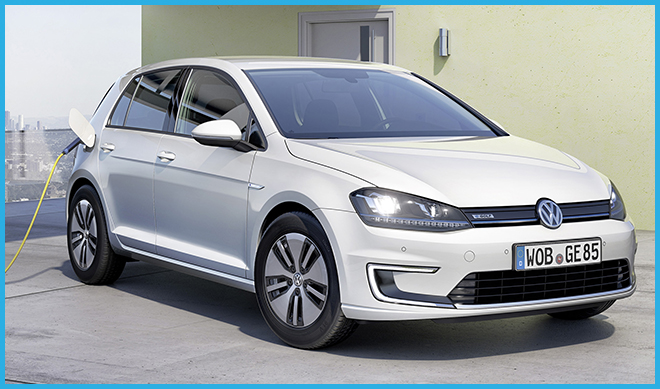

A round of e-Golf
When the Volkswagen Golf debuted in 1974, few could have predicted that it would eventually sell more than 30 million units, to become the bestselling European car ever. 40 years later in America, the fully electric VW e-Golf debuted in 11 states this November (including California, Oregon, New York, Connecticut, Maryland, Massachusetts, Rhode Island and Vermont). It lures prospective buyers with its 116 MPGe efficiency rating (as well as an EPA range of 83 miles), which makes the e-Golf the most efficient compact EV of the 2015 model year. It’s priced at $35,445, in the range of the other EVs in its peer group: the Nissan LEAF ($29,010-35,120 MSRP), Ford Focus Electric ($29,170), BMW i3 ($41,350-45,200) and Mercedes-Benz B-Class Electric Drive ($41,450). As an alternative, a 36-month US lease costs $1,999 down and $299 a month.


I had a chance to test-drive the e-Golf through the streets and autobahns of Wolfsburg and neighboring Braunschweig, as part of a group showcase for the e-Golf’s American launch and a display of VW’s EV manufacturing base. Similar to other EVs, the e-Golf’s available torque (199 lb-ft) kicks in immediately, so its pep off the starting blocks is matched only by the soothing silence of the ride. With the ample acceleration, it was tempting to keep the e-Golf in the Normal drive mode the whole time and let it rip on the autobahn whenever possible. However, I wanted to sample its Eco and Eco+ modes as well, which you can comfortably flip between from the steering-wheel controls. Those modes limit the available torque, top speed and air conditioning to varying degrees. The Eco modes are there to help maximize range, but they make the e-Golf a little less fun to drive – the difference in available torque is apparent.
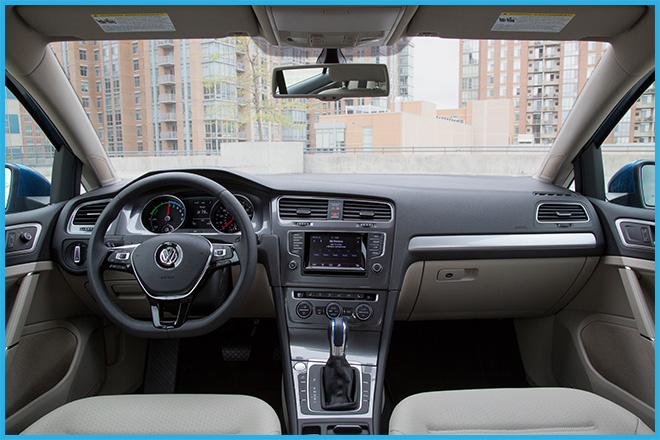

Regardless of the drive mode, the e-Golf has four degrees of regenerative braking available, ranging from none to extreme. Regen modes are controlled by tapping the shifter left and right, or nudging it down for B mode – the most extreme regen mode. I enjoyed finding my personal sweet spot for regenerative braking (level 3), and using it as an efficient substitute for most braking other than complete stops. For safety, the regenerative braking activates the brake lights.
The dash display clearly shows the current drive mode, regen and other useful info like the distance traveled and remaining range. As a nice old-school touch, an analog “fuel” gauge shows you the battery’s state of charge (SOC) underneath the speedometer. You can get more detailed information on the range and energy flow, as well as the navigation capabilities and satellite radio, from the 8-inch touchscreen display above the shifter on the dashboard.
While driving the e-Golf was a little more stimulating, riding as a passenger in the front and back seats also proved to be pleasant. The four-door e-Golf has the same 93.5 cubic feet of interior space as the standard Golf, and it feels generously spacious for a compact EV. Families should appreciate its near-rectangular rear storage as well, rather than a geometrically odd-shaped boot.
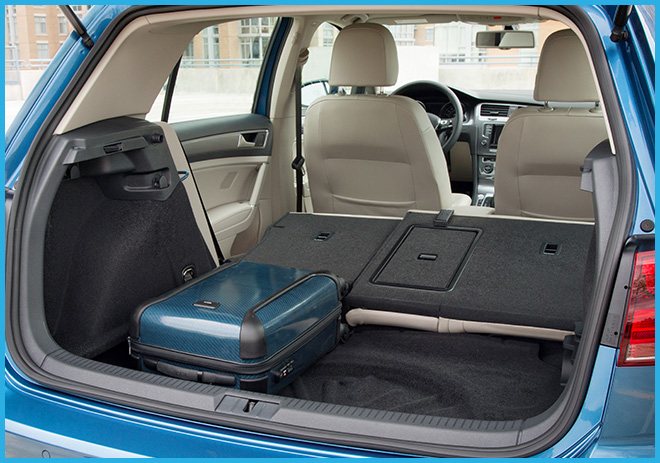

I also got a chance to test drive the Golf GTE, the PHEV member of the Golf line. Driving it in all-electric mode, in which it has a 31-mile approximate range, was a nearly identical experience to the e-Golf, which is kind of the point of the MQB modular production – to produce the same model of car with different drive types. Although the Golf GTE is not currently scheduled for sale in the US, it could be introduced there easily, according to Christian Buhlmann, of Volkswagen AG Product Communications. Because of VW’s MQB platform, the company can be fleet with its fleets, so to speak. “The e-Golf is made here in Wolfsburg,” Buhlmann said, “but it could be switched to North America if there is the demand.”
Inside the wolf’s den
The Volkswagen Wolfsburg factory feels like a world unto its own. It has its own roads with bikes, VW cars and in our case, modified Golf tourist carriers that traverse the endless blocks of busy robots, inventoried parts and thousands of workers. As Dr. Harald Manzenrieder, Head of e-Golf Production at the Wolfsburg plant, rattled off facts about the factory, the numbers painted a picture on a huge scale. Every day, the factory runs for 19.5 hours of production, using 2,600 tons of steel and producing about 3,800 cars – one car every 18.4 seconds.
All of that production represents only two main VW product lines, the Golf (2,200 cars a day) and the Touareg/Tiguan SUVs (1,600 cars a day). While the Golf already utilizes the MQB modular assembly kits, the Touareg/Tiguan line will be the next to adopt the MQB platform, opening the way for electrification, which VW plans eventually for all of its vehicle classes, including the other Volkwagen Group brands.
The circumstances behind VW’s headquarters – a town purpose-built to support a factory, followed by the long tradition of a successful company producing reputable vehicles – has made the Wolfsburg factory something of an anomaly today. “Nobody does this anymore,” Buhlmann said. “It doesn’t make sense for them.”
However, it does make sense for Wolfsburg, where production line 3 has been dedicated to producing the e-Golf and Golf GTE models. It has the capacity to make 1,100 cars a day. As of late October the factory was producing about 100 total e-Golf and Golf GTE units a day – 60-70 of which were e-Golfs, each car with 8,000 distinct parts. “We have the scale we need to develop the components ourselves,” Buhlmann said, “and we are fine with however many orders we get for whichever powertrain.”
A case of batteries
While Wolfsburg takes care of vehicle assembly, certain components of the electrified vehicles are farmed out to satellite factories. As part of VW’s push toward electrification, it hired an additional 400 electric drive experts, and the e-Golf’s motor/gearbox unit is made at the Volkswagen components plant, a two-hour drive away in Kassel.
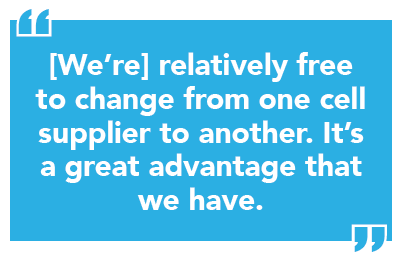

Meanwhile, Volkswagen has battery facilities just 24 miles away in a Braunschweig factory. While VW used NiMH batteries for its early hybrids, the company switched to Li-ion for the Jetta hybrid in 2012. The e-Golf uses 25 Ah prismatic cells from Panasonic with nickel-manganese-cobalt chemistry. VW packages the cells and integrates battery management controls at the Braunschweig factory, which employs 170 engineers. The combination of an outside cell supplier and in-house battery pack development leaves the company “relatively free to change from one cell supplier to another,” said Dr. Holger Manz, Head of Battery and Suspension Development at the Braunschweig plant. “It’s a great advantage that we have.”
The battery development team evaluated many different options, including small cylindrical 18650 cells (the same package size as the cells in Tesla’s Model S), and in 2012 chose to go with Panasonic’s larger-format 25 Ah cells. Dr. Manz said that the 18650 cells the company tested “do not have the safety levels of the cells we’re using now.”
The final production version of the e-Golf’s battery pack was designed in such a way that it does not require any active cooling – neither liquid nor forced-air. Originally, prototypes did utilize cooling in the initial testing phase, but the team decided it had enough heat dissipation on its own. “It has enough size and surface area that it dissipates for the amount of power that it needs,” said Dr. Manz.
The e-Golf uses a total of 264 cells in 27 modules of either six or 12 cells, for 24.2 kWh of capacity. The 323 V pack weighs about 701 lbs, or 21% of the vehicle’s curb weight.
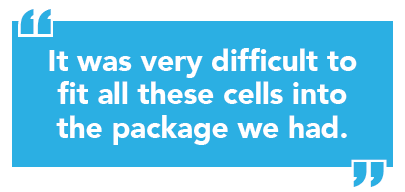

Some EV developers have enjoyed the freedom of an original chassis designed specifically for electrification (like BMW’s i3 and Tesla’s Model S), however the e-Golf battery team had a chassis restricted to the specs that would work with the Golf MQB system. “It was very difficult to fit all these cells into the package we had,” Manz said.
In the end, they worked with Panasonic on the particular cell size to fit the pack underneath the front and rear seats and middle tunnel. The VW team boasts that the final design not only reinforced the vehicle floor, but also lent the car extra heft thanks to its low center of gravity – enhancing the car’s handling.
The Braunschweig battery plant – the only full battery factory in the VW Group – can crank out an e-Golf battery pack every 20 minutes. The process is highly automated, and the team is working on getting the individual time down to 15 minutes in anticipation of increased demand.
The fully assembled packs go through system function tests, mechanical tests, climate tests, thermal analysis tests and a Hardware in the Loop (HIL) test before they arrive at Wolfsburg with a 90% SOC.
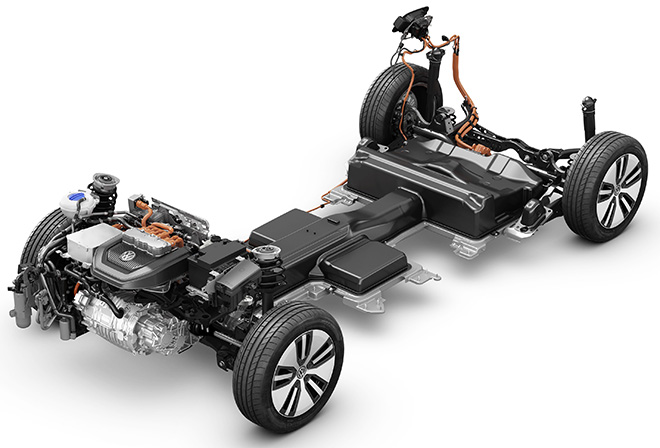

Compliance or defiance?
With every new EV release, we can’t escape the inevitable question: Is this a compliance car? We’ve come to expect the automaker’s answer to that question to go something (exactly) like this: “Absolutely not. We’re rolling out this car initially in the states where we see the most demand, and we’ll expand its reach as sales dictate.” Of course, the states where they see the most demand are the ZEV states, where local mandates and incentives effectively create some demand, but if the automaker does nothing to market the car, sales won’t dictate an expansion of its reach, and the car will die on the vine.
So, while most automakers issue similar boilerplate on compliance, we eventually develop our own ideas about whether an EV is a compliance car (Ford Focus Electric) or not (BMW i3). In VW’s case, one of our PR contacts gave us the expected answer on compliance, so we’re left to wait, see and speculate.
Our speculation: Volkswagen is clearly investing in electrification, but so is everyone else beholden to compliance. We’re not sure if VW is investing more than other automakers, but with its drivetrain-interchangeable MQB system, it is investing differently. In 2013, 23.5% of all of the 300+ VW models sold in 153 countries were diesel, so even without the concern for a transition to electricity or the question mark of fuel cells, VW already had ample reason to perfect a drivetrain-agnostic approach to its product lines.
With MQB now in place and slowly spreading out to all of the VW Group’s lines, the automaker can invest in any and all drivetrain possibilities more efficiently, using effectively the same powertrain across several product lines and expanding to fulfill the need for whatever drive type takes off. It’s a different approach to the “wait and see what the demand dictates” strategy, but if it means faster availability for more EV models, that should be a welcome sign for EV believers. Sure, it may not be as exciting to see the same old VW models electrified as it is to see a brand-new EV-only design unveiled, but it should free up some R&D resources that can instead be used to spread around electric drivetrains and on marketing. After all, this is the “people’s car,” not the glitterati’s dream machine.
Also, the question of compliance has to expand out to the world at large rather than focus narrowly on the United States. As Buhlmann pointed out, CARB standards are not the only guidelines out there. China is working on similar rules, and while the specific requirements may not be the same, Europe also has ambitious carbon-reduction plans for its businesses.
What’s next
As we contemplate the depth of VW’s commitment to EVs, the Volkswagen Group’s plug-in vehicle plans roll on as e-Golfs roll off the Wolfsburg assembly lines.
Using essentially the same PHEV powertrain as the Golf GTE, the VW Passat GTE debuted at this year’s Paris Motor Show, and should start delivering to European markets in October 2015. It has a total peak output of 215 hp, a peak torque of 295 lb-ft and a 9.9 kWh battery pack, as opposed to the Golf GTE’s 8.7 kWh battery (but the two cars have the same all-electric range of 31 miles). There probably won’t be a Passat GTE in the US until later in the decade, because VW uses a slightly different Passat design in the US, and it won’t be replaced yet.
Stateside drivers will have a chance to experience the GTE a bit sooner in the form of the 2016 Audi A3 e-tron PHEV, which has basically the same powertrain as the European VW GTE models. However, the Audi modular system is called MLB (Porsche’s is called MSB), rather than VW’s MQB. The Audi A3 e-tron, which Green Car Reports said featured “well-tuned responses and zippy performance,” and about a 25-mile all-electric range, should be on sale in the US in the summer or autumn of 2015.
In the meantime, those who would like to see more BEVs in the pipeline are anxiously awaiting the battery developments that would clear the way for more affordable long-range vehicles. Volkswagen says it has its hat in that ring – pushing the capabilities of current and next-gen technology simultaneously. At the Wolfsburg factory, Dr. Manzenrieder assured us that they are putting a lot of “brain power” and R&D into next-gen longer-range battery technology, and he expects to see something “in the very near future.” He said, “it’s not a think tank here; it’s a do tank.”


In July, Volkswagen Group’s Professor Dr. Wolfgang Steiger gave a presentation in London revealing the company’s short-term road map to improving energy density. Dr. Steiger said that VW sees a clear path from the 25 Ah cells in the e-Golf to 28 Ah, 34 Ah, and 36 Ah cells in the near future, which would increase the energy density of the pack from the 170 Wh/kg in the current e-Golf to about 220 Wh/kg. When combined with advances in weight savings, aerodynamics and overall efficiency, this could give VW’s EVs a range of about 165 miles without any breakthroughs in exotic battery chemistries.
However, the company is leaving no rock unturned, and is exploring advanced chemistry options like Li-sulfur and Li-air through its different organizations, including its research facility in Palo Alto, California.
At a Stanford University speech in November, Dr. Martin Winterkorn, Chairman of the Board of Volkswagen, dropped a hint as to what that next big thing may be: solid-state batteries. Replacing traditional liquid electrolytes with a nonflammable inorganic solid electrolyte simplifies battery design while improving safety and durability, and could boost EV range to as much as 435 miles, at a volumetric energy density of about 1,000 Wh/l. Solid states could also be packaged more efficiently in series stacks and bi-polar structures using large-capacity electrode materials such as sulfur and lithium metal.
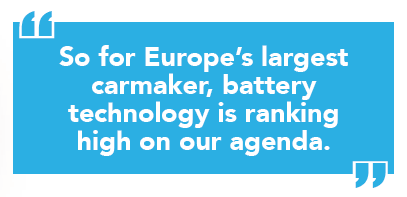

“High-performance energy storage is key to big challenges of our times – namely, climate protection and a sustainable mobility,” Dr. Winterkorn said. “To really succeed with electric vehicles, we need batteries with a higher range, less weight and lower cost. It is crucial for economies of scale in purchasing and production. So for Europe’s largest carmaker, battery technology is ranking high on our agenda. If we also improve reliability and battery lifespan, customer acceptance will grow fast. We are reaching out to the world of science to make all this happen. Of course, these are complex challenges, and progress is not attained overnight.”
What does happen overnight: Wolfsburg pumping out car after car. And the only thing that decides whether those cars are plug-ins or not is demand.
This article originally appeared in Charged Issue 15 – August/September 2014




